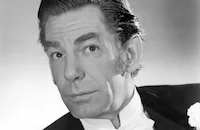Horror of Dracula

Brief Synopsis
Cast & Crew
Terence Fisher
Peter Cushing
Christopher Lee
Michael Gough
Charles Lloyd Pack
Barbara Archer
Film Details
Technical Specs
Synopsis
First attempt at a close to faithful adaptation of the Bram Stoker's classic, but filled with plenty of thrills and chills.
Director

Terence Fisher
Cast

Peter Cushing

Christopher Lee

Michael Gough
Charles Lloyd Pack
Barbara Archer
George Woodbridge
Stedwell Fulcher
Valerie Gaunt
Dick Morgan
Carol Marsh
Paul Cole
George Benson
John Van Eyssen
Olga Dickie
Janina Faye
Judith Nelmes
Miles Malleson
William Sherwood
Geoffrey Bayldon
George Merritt
Humphrey Kent
Melissa Stribling
Guy Mills
Crew
Molly Arbuthnot
Jack Asher
James Bernard
Michael Carreras
Doreen Dearnaley
Tom Edwards
Len Harris
Anthony Hinds
John Hollingsworth
Phil Leakey
Bill Lenny
Robert Lynn
Jock May
Henry Montsash
James Needs
Anthony Nelson Keys
Bernard Robinson
Jimmy Sangster
Bram Stoker
Don Weeks
Photo Collections
Videos
Movie Clip






Trailer
Hosted Intro
Film Details
Technical Specs
Articles
Horror of Dracula
Hammer had made horror films before. In fact, it made all kinds of movies in the years before it took on the legend of the bloodsucking count. Until the mid-1950's, this family-owned studio was little-known outside England. Even there, Hammer's claim to fame was for film versions of BBC radio serials. This changed after an adaptation of the early television science-fiction drama The Quatermass Xperiment (1955) proved to be a moneymaker in the U.S. where it was released as The Creeping Unknown. From science-fiction it was a short step to outright horror movies and here, Hammer found a way to add something new: color.
Until then, horror was closely associated with black and white. This not only created what was considered the appropriate shadowy atmosphere but also downplayed the gorier aspects of horror. Weak stomachs could handle a bit of blood spilling when it was black instead of red. Hammer obliterated that monochrome world with their first classic horror adaptation, The Curse of Frankenstein (1957), presented in widescreen and brilliant Technicolor. The critics carped but audiences loved it, leading the studio inevitably to the other great monster of classic cinema, Dracula.
Jimmy Sangster adapted the story liberally from the Bram Stoker novel, making Dracula's opponents more active than in the original book. Jonathan Harker is here only pretending to be a real estate agent. He is actually a vampire hunter sent by Dr. Van Helsing, Dracula's main nemesis. Peter Cushing turns Van Helsing into an action hero. At one point Cushing insisted on leaping over a banister despite the studio's fears that the star would injure himself. Cushing is still considered to be the screen's best Van Helsing, a remarkable feat since both Anthony Hopkins and Laurence Olivier have played the role. As for being typecast as a horror actor, Cushing doesn't mind the stereotyping. As he said in the biography, Hammer Horror by Tom Johnson and Deborah Del Vecchio,"for any actor to be associated with a form of success like Hammer's, I think it's absolutely wonderful; and if that means being thought of as a 'horror actor,' then I think it's the most marvelous thing that could happen to me."
Surpassing the casting of Cushing as Van Helsing, however, is Christopher Lee as Dracula. His deep, aristocratic voice and regal six-foot, five-inch stature combined with an ability to suddenly exhibit animalistic fury allowed Lee to turn the count from Bela Lugosi's Continental seducer into a truly terrifying monster. Lee would forever be associated with Dracula, much to his personal chagrin. Ironically enough, Lee is only on the screen a total of seven minutes in Horror of Dracula yet his frightening presence is felt through the film.
Dracula was the title in the United Kingdom, but in America it became Horror of Dracula because of fears that audiences would assume it was yet another re-release of the 1931 movie. Under any title, it was massively popular. One theatre set a British attendance record less than a month after the movie's release. However, not everyone was so pleased. British film critics went into hysterics over the combination of bright-red blood and the low-cut nightgowns of Dracula's female victims. One typical review came from the Daily Telegraph: "This British film has an X certificate. This is too good for it. There should be a new certificate - 'S' for sadistic or just 'D' for disgusting." Such reviews only increased the box office take.
"HAMMER - the company that's injecting fresh blood into the film industry," bragged the studio in the trade press. The success of Horror of Dracula led the studio to cancel all their non-horror productions, focusing instead on remakes of classic chillers like The Mummy (1959) and The Phantom of the Opera (1962) as well as an on-going series of Dracula films
Producer: Michael Carreras, Anthony Hinds, Anthony Nelson Keys
Director: Terence Fisher
Screenplay: Jimmy Sangster
Cinematography: Jack Asher
Film Editing: Bill Lenny
Art Direction: Bernard Robinson
Music: James Bernard
Cast: Peter Cushing (Doctor Van Helsing), Christopher Lee (Count Dracula), Michael Gough (Arthur Holmwood), Melissa Stribling (Mina Holmwood), Carol Marsh (Lucy), Olga Dickie (Gerda).
C-82m. Letterboxed. Closed captioning.
by Brian Cady

Horror of Dracula
Quotes
Trivia
In the United States the title was changed to "Horror of Dracula" to avoid confusion with the classic 1931 version (_Dracula (1931)_ ). This was a real concern since the Bela Lugosi version was still being booked into theatres (through Realart) until the Shock Theatre package of classic Universal horror films was released to television.
Miscellaneous Notes
Released in United States Summer June 1958
The first installment of the famous Hammer "Dracula" series starring Christopher Lee.
Released in United States Summer June 1958

















